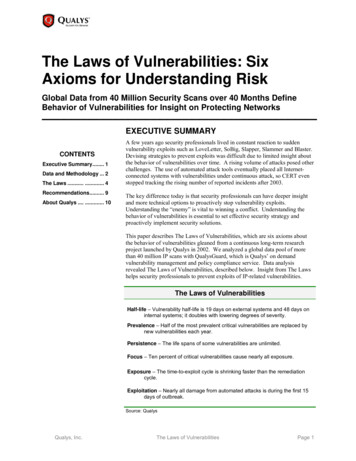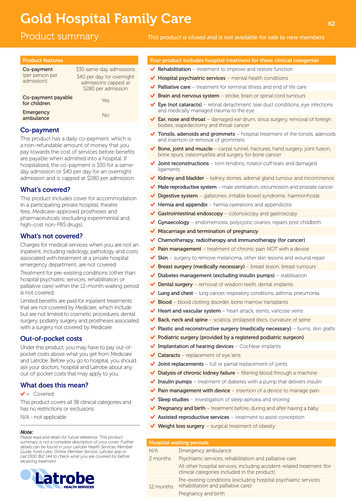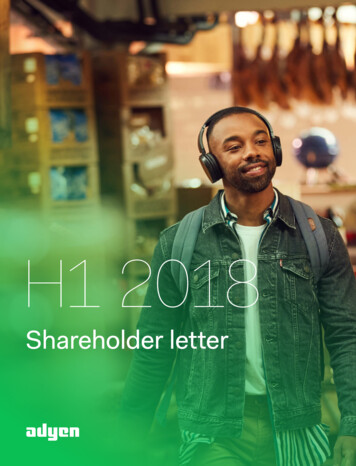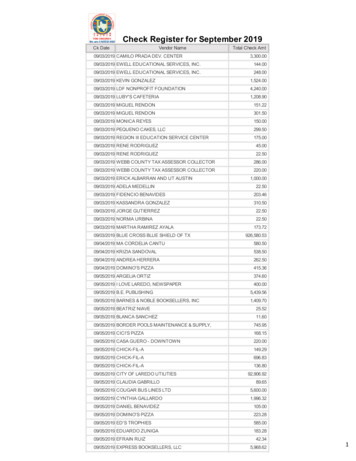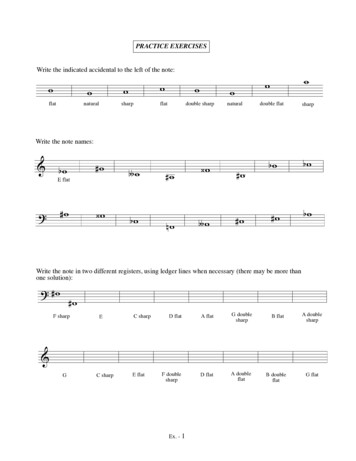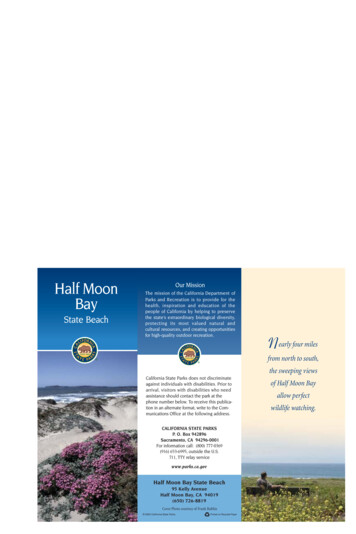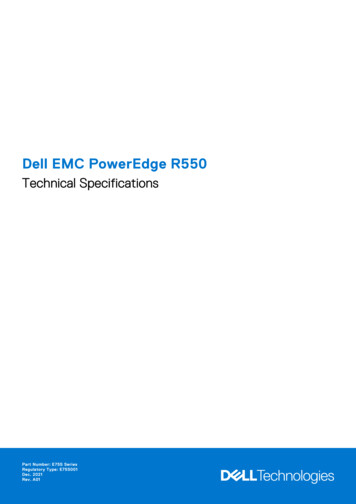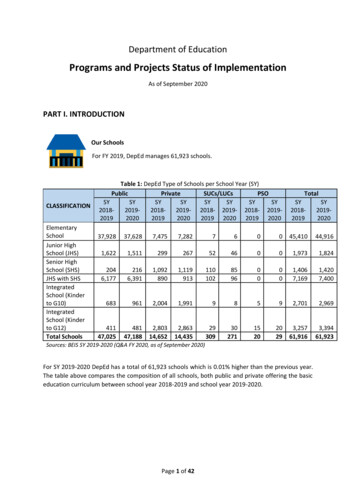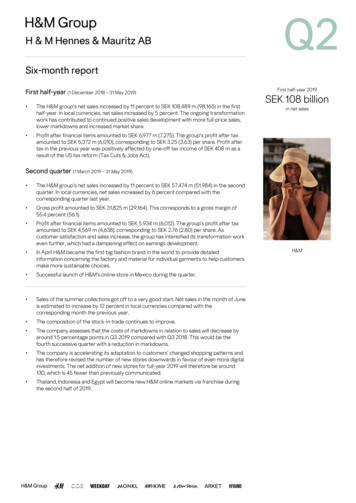
Transcription
H & M Hennes & Mauritz ABQ2Six-month reportFirst half-year (1 December 2018 – 31 May 2019) The H&M group’s net sales increased by 11 percent to SEK 108,489 m (98,165) in the firsthalf-year. In local currencies, net sales increased by 5 percent. The ongoing transformationwork has contributed to continued positive sales development with more full-price sales,lower markdowns and increased market share. Profit after financial items amounted to SEK 6,977 m (7,275). The group’s profit after taxamounted to SEK 5,372 m (6,010), corresponding to SEK 3.25 (3.63) per share. Profit aftertax in the previous year was positively affected by one-off tax income of SEK 408 m as aresult of the US tax reform (Tax Cuts & Jobs Act).First half-year 2019SEK 108 billionin net salesSecond quarter (1 March 2019 – 31 May 2019) The H&M group’s net sales increased by 11 percent to SEK 57,474 m (51,984) in the secondquarter. In local currencies, net sales increased by 6 percent compared with thecorresponding quarter last year. Gross profit amounted to SEK 31,825 m (29,164). This corresponds to a gross margin of55.4 percent (56.1). Profit after financial items amounted to SEK 5,934 m (6,012). The group’s profit after taxamounted to SEK 4,569 m (4,638), corresponding to SEK 2.76 (2.80) per share. Ascustomer satisfaction and sales increase, the group has intensified its transformation workeven further, which had a dampening effect on earnings development. In April H&M became the first big fashion brand in the world to provide detailedinformation concerning the factory and material for individual garments to help customersmake more sustainable choices. Successful launch of H&M’s online store in Mexico during the quarter. Sales of the summer collections got off to a very good start. Net sales in the month of Juneis estimated to increase by 12 percent in local currencies compared with thecorresponding month the previous year. The composition of the stock-in-trade continues to improve. The company assesses that the costs of markdowns in relation to sales will decrease byaround 1.5 percentage points in Q3 2019 compared with Q3 2018. This would be thefourth successive quarter with a reduction in markdowns. The company is accelerating its adaptation to customers’ changed shopping patterns andhas therefore revised the number of new stores downwards in favour of even more digitalinvestments. The net addition of new stores for full-year 2019 will therefore be around130, which is 45 fewer than previously communicated. Thailand, Indonesia and Egypt will become new H&M online markets via franchise duringthe second half of 2019.H&M
Six-month report 2019 (1 Dec 2018 – 31 May 2019)Comments by Karl-Johan Persson, CEO“The H&M group continues to increase full-price sales, reduce markdowns and increase marketshare, showing that customers appreciate our collections and the improvements we aremaking to the product assortment and the customer experience.Sales developed well in most markets. We had strongest growth in countries such as the USwhere we grew sales by 17 percent, in Mexico by 25 percent, in India by 39 percent, in Russiaby 19 percent and in Poland by 11 percent in local currencies. We also grew in the UK andSweden where we took market share despite challenging market conditions.Total sales in the group increased by 11 percent in SEK and with 6 percent in local currencies inthe second quarter. Online sales continued to develop strongly, increasing by 27 percent in SEKand 20 percent in local currencies.By continuing to integrate our physical and digital channels we are making the shoppingexperience inspiring, easy and convenient for customers wherever we meet them. This andother extensive investments are driving costs in the short term. For example, our new onlineplatform and our new logistics systems have not yet achieved full efficiency, but for customershave resulted in improvements such as faster and more flexible deliveries and a more seamlessshopping experience. We have also increased the value for our customers through furtherinvestments in the customer offering so that we offer the best combination of fashion, quality,price and sustainability. In April H&M became the first big fashion brand in the world to providedetailed information concerning the factory and material for individual garments to helpcustomers make more sustainable choices. We have continued to develop our new digitalfeatures and during the spring we also substantially expanded H&M’s customer loyaltyprogramme, which now has more than 43 million members.& Other StoriesThe transformation work is having an effect and will continue at a fast pace within our strategicfocus areas:Create the best customer offeringProduct assortment – secure the best combination of fashion, quality, price and sustainability forall the brands.Physical stores – continued development of new concepts and optimisation of the store portfolio.Online stores – improvements such as faster and more flexible delivery options and payments.Continued integration of our physical stores and online stores to enhance the customerexperience.Fast, efficient and flexible product flowMake the supply chain even faster, more flexible and more efficient.Initiatives within advanced data analytics and AI.Investments in infrastructure – our tech foundationContinued investments in our tech foundation including robust scalable platforms that enablefaster development of various customer apps and new technologies.Adding growthDigital expansion into new markets. In April H&M opened online in Mexico, and this autumn H&Mwill launch online via franchise in Thailand, Indonesia and Egypt. In addition, partnerships withvarious external platforms are making the H&M group’s brands available to more and morecustomers globally. In autumn 2019 H&M will launch on India’s largest ecommerce platform Myntraand in China & Other Stories will open on Tmall.Physical stores – continued expansion with focus on growth markets. The planned net addition forthe full-year is around 130 stores.Develop new concepts and business models.Our transformation work in response to the rapid shift in fashion retail is continuing at fullspeed. While the costs of this have held back profitability in the short term, we remainconvinced that our focus on meeting customers’ increased expectations will contribute to agradual increase in profitability and to long-term positive development for the H&M group. ”Read more about our initiatives and our sustainability work on the next page and at hmgroup.com.2
Six-month report 2019 (1 Dec 2018 – 31 May 2019)Initiatives for an improved customer experienceThe H&M group continues to enhance the customer experience. Improvements are beingmade throughout the supply chain, from product development to a more inspiring shoppingexperience, to meet customers’ increased expectations. Here are some examples: Ongoing tests to enhance the in-store shopping experience for customers in severalmarkets. We evaluate these tests on an ongoing basis and are gradually rolling out thesolutions that work best as we upgrade stores and open new stores. The integration of online and physical channels continues. Convenience andaccessibility are becoming increasingly important to customers. H&M’s mobile appand hm.com are being upgraded on an ongoing basis with improved navigation andproduct visuals as well as wider payment options, all enhancing the customerexperience. The improvements that have been made have for example caught theattention of Retail Week which recently ranked H&M second among digital retailers inthe UK.oMembers of H&M’s customer loyalty programme will be able to shop andpay later against invoice, whether shopping in store or online. This will beintegrated into the H&M app in 8 markets in 2019 starting with Switzerlandin August, closely followed by the UK.oDuring the summer we are introducing the option for H&M members to getdigital store receipts in the H&M app instead of being given physical receiptsin the store. Launched in the US and UK during the summer, further marketswill get this service in the autumn.oNotify-if-back is a service that allows customers to be notified when the sizethey want is available again in store or online.oNew product visuals, including videos, in H&M’s online store. To give ourcustomers an even better and more realistic idea of the garments we arenow testing out videos in the online store.oVisual Search is today available in 29 markets and uses image recognition tohelp customers move directly from inspiration to purchase.oNext day delivery is offered in 12 markets in 2019. Same day delivery is beingevaluated in a number of these markets and has been launched in countriesincluding the Netherlands and the UK.oFind in Store is now in 20 markets and more markets will be added duringthe year. This function lets customers use their mobile to find an item theyhave seen online in the right size and at the right store.oScan & Buy is available in all 48 online markets. The customer scans the QRcode on a product in store to find and buy the item online in the size andcolour they want.oIn-Store Mode shows customers which items are in the store they arecurrently in, as well as online. This mobile service is available in9 markets and will be launched in more markets in 2019.oClick & Collect is available in 11 markets and more markets will get theservice in 2019.oOnline returns in store – available in 15 markets and will be rolled out furtherin 2019.H&M3
Six-month report 2019 (1 Dec 2018 – 31 May 2019)o#HMxME is a gallery that invites customers to share their own fashion storiesfrom Instagram while also providing an easy way to buy the items in theimages. #HMxME is available in 47 markets. Since 2013, when we published our supplier list, H&M has taken various steps toincrease transparency and on 23 April this year H&M became the first big fashionbrand in the world to provide detailed information concerning the factory andmaterial for individual garments. This applies both online and also in store, wherecustomers can scan the garment’s price label to see this information. We hope thisservice will help our customers make more sustainable choices and will contribute tolong-term sustainable development. Continued global expansion of RFID, currently in 15 H&M markets. The global roll-outwill continue to more markets in 2019. H&M’s upgraded customer loyalty programme now has over 43 million members.Today the customer loyalty programme can be found in 19 markets, the latestadditions being the US, Canada and Russia. By the autumn H&M’s customer loyaltyprogramme will be integrated into the Chinese communications app WeChat, whichhas around a billion users. By autumn 2019 H&M will be launched on India’s leading ecommerce platform Myntra.This means that millions of customers all over the country will gain access to and beable to experience the best of H&M and have the products delivered directly to theirhomes. & Other Stories will be launched on Tmall in China by the autumn 2019. Increased automation and optimisation of the logistics network for greater flexibility,and increased integration of physical stores and online.4
Six-month report 2019 (1 Dec 2018 – 31 May 2019)SalesSEK m125,000 11%100,00098,16575,00050,000108,489 11%201857,47451,984201925,0000Q2Six monthsH&MNet sales increased by 11 percent to SEK 57,474 m (51,984) in the second quarter. Net sales inthe six-month period increased by 11 percent to SEK 108,489 m (98,165). In local currencies theH&M group’s net sales increased by 6 percent in the second quarter and by 5 percent in thesix-month period.Online sales in the second quarter increased by 27 percent in SEK and in local currencies theincrease was 20 percent.New Business increased sales in the second quarter by 21 percent in SEK and by 18 percent inlocal currencies.Sales in top ten markets, second quarterQ2 - 2019Q2 - 2018SEK mSEK mnet salesnet na3,119France2,731Change in %SEK31 May - 19Q2 - 2019LocalNumber ofNew 2572Others*Total* Of which franchisesSales in Germany were affected by fine-tuning required following the transition of the onlineplatform at the beginning of the year. Sales have gradually picked up again and towards theend of the second quarter exceeded last year’s sales.The difference between the sales increase in SEK and in local currencies is due to how the Swedish krona has developedagainst the overall basket of currencies in the group compared with the same period last year.5
Six-month report 2019 (1 Dec 2018 – 31 May 2019)Gross profit and gross marginSEK 35155.4%56.1%201831,82529,164201910,0000Q2Six monthsARKETGross profit increased by 9 percent and amounted to SEK 31,825 m (29,164) in the secondquarter, corresponding to a gross margin of 55.4 percent (56,1). For the six-month period, grossprofit amounted to SEK 57,351 m (52,204), corresponding to a gross margin of 52.9 percent(53.2).Costs for markdowns in relation to sales decreased by around 1 percentage point in the secondquarter of 2019 compared with the corresponding quarter in 2018.The gross profit and gross margin are a result of many factors, internal as well as external, andare mostly affected by the decisions that the H&M group takes in line with its strategy toalways have the best customer offering in each individual market – based on the combinationof fashion, quality, price and sustainability.For the second quarter the external factors influencing purchasing costs were negative overall,mainly as a result of the gradual strengthening of the US dollar against the group’s basket ofcurrencies compared with the same purchasing period the previous year. The gross marginwas also affected by continued investments in an even stronger customer offering and bycosts for the intensified transformation work.For purchases made for the third quarter 2019 the overall market situation as regards externalfactors is expected to remain negative – mostly due to the strengthening of the US dollaragainst the group’s basket of currencies compared with the same purchasing period theprevious year.6
Six-month report 2019 (1 Dec 2018 – 31 May 2019)Selling and administrative expensesSEK m60,000 12%50,00040,00044,98930,00020,00023,15750,411 12%201825,890201910,0000Q2Six monthsH&M HomeIn the second quarter of 2019, selling and administrative expenses increased by 12 percent inSEK and by 7 percent in local currencies compared with the corresponding period the previousyear. For the six-month period, selling and administrative expenses increased by 12 percent inSEK and by 7 percent in local currencies compared with the corresponding period the previousyear. Cost control in the group remains good.The cost increase in the quarter is mainly explained by store and online expansion, but also bythe group’s ongoing transformation work with investments in focus areas such as AI, tech,logistics and H&M’s customer loyalty programme.Profit after financial itemsSEK m10,0008,0006,000- 4%- 1%6,0127,2756,9775,93420184,00020192,0000Q2Six monthsProfit after financial items amounted to SEK 5,934 m (6,012) in the second quarter. Profit in thesix-month period amounted to SEK 6,977 m (7,275).The group’s ongoing transformation work contributed to continued positive sales developmentwith more full-price sales, lower markdowns and increased market share. As customersatisfaction and sales have increased, the transformation work has been further intensified.While the costs of the group’s initiatives have had a dampening effect on profitability, thecompany expects the initiatives to gradually contribute to an increase in the profitability of theH&M group.7
Six-month report 2019 (1 Dec 2018 – 31 May 2019)Stock-in-tradeCurrency adjusted the stock-in-trade increased by 4 percent. In SEK the book value of stock-intrade increased by 11 percent to SEK 40,406 m (36,333). The book value of stock-in-trade inSEK represented 32.4 percent (32.3) of total assets and 18.3 percent (18.2) of sales for therolling 12 months, which amounted to SEK 220,724 m (199,801).The composition of the stock-in-trade continues to improve. The company therefore assessesthat the costs of markdowns in relation to sales will decrease by around 1.5 percentage pointsin the third quarter in a year-on-year comparison. This would be the fourth successive quarterwith a reduction in markdowns.ExpansionThe global integration of stores and online continues. Work is continuing at full speed to roll outonline globally to all existing H&M markets and to other markets as well. Today H&M online is in48 markets. Thailand, Indonesia and Egypt are scheduled to become new H&M online marketsvia franchise during the second half of 2019, when H&M will also be launched on Myntra, India’slargest ecommerce platform, and & Other Stories will be launched on Tmall in China.MonkiIn addition to Bosnia-Herzegovina, which has already opened, Belarus and (via franchise) Tunisiawill become new H&M store markets in 2019.The company is accelerating its adaptation to customers’ changed shopping patterns and hastherefore revised the number of new stores downwards. The net addition of new stores forfull-year 2019 will therefore be around 130, which is 45 fewer in the second half than previouslyassessed.For the 2019 financial year around 295 new stores are planned to open, of which around 220will be H&M stores. Around 75 of the year’s store openings will be COS, & Other Stories, Monki,Weekday, ARKET and Afound stores. A total of three standalone H&M Home stores areplanned to open in 2019. The majority of the H&M store openings will be in markets outside ofEurope and the US.In total, approximately 165 store closures are planned within the group, which is part of theintensified store optimisation being carried out that also includes renegotiations, rebuilds andadjustment of store space to ensure that the store portfolio is the best fit for each market.8
Six-month report 2019 (1 Dec 2018 – 31 May 2019)BrandH&MNo. of marketsExpansion31 May - 20192019StoreOnline7248New marketsStore: Bosnia-Herzegovina*,Belarus, Tunisia (franchise)Online: Mexico*, Egypt(franchise), Thailand (franchise),Indonesia (franchise)COS4222Store: Iceland, Lithuania, SlovakiaOnline: Norway*Monki1719Store: Iceland*, Poland, UnitedArab Emirates (franchise)**Online: Norway*Weekday1219H&MStore: Iceland*, Luxembourg*Online: Norway*& Other Stories1916Store: Luxembourg*, LatviaOnline: Norway*, China (Tmall)ARKET719Store: Luxembourg*Online: Norway*AfoundH&M HOME115141Online: NetherlandsOnline: Mexico*, Kazakhstan* Opened until 31 May - 2019** Opened in June 2019Store count by brandIn the first half-year, excluding franchise, the group opened 83 (105) stores and closed 74 (65)stores, i.e. a net increase of 9 (40) new stores. Via franchise partners 8 (22) stores were openedand 6 (0) stores were closed. The group had 4,979 (4,801) stores as of 31 May 2019, of which257 (241) were operated by franchise partners.As previously communicated, Cheap Monday will be closed down in summer 2019. The H&Mgroup’s transformation work in response to the extensive changes within the fashion industrymeans that the company is prioritising and focusing on its core business. Cheap Monday’sbusiness model is based on traditional wholesale, which is a model that has faced majorchallenges due to the shift in the industry. The H&M group has therefore decided to closedown Cheap Monday.New StoresTotal No of stores2019 ekday64434& Other Stories17062Cheap Monday001ARKET1199Afound060H&M HOME*2100214,9794,801Total31 May - 2019 31 May - 2018* Concept stores, H&M HOME is included with 373 shop-in-shop in H&M stores.9
Six-month report 2019 (1 Dec 2018 – 31 May 2019)Store count by regionNew StoresTotal No of stores2019 (net)RegionQ231 May - 2019 31 May - 2018Europe & Africa43,0593,014Asia & Oceania131,1721,090North & South AmericaTotal4748697214,9794,801TaxThe H&M group’s tax rate for the 2018/2019 financial year is expected to be approximately22.0 – 23.0 percent. In the first, second and third quarters of 2019 a tax rate of 23.0 percent willbe used to calculate tax expense on the result of each quarter. The outcome of the tax rate forthe year depends on the results of the group’s various companies and the corporate tax ratesin each country.Current quarterSales of the summer collections got off to a very good start. Net sales in the month of June isestimated to increase by 12 percent in local currencies compared with the correspondingmonth the previous year.The company therefore assesses that the costs of markdowns in relation to sales will decreaseby around 1.5 percentage points in Q3 2019 compared with Q3 2018. This would be the fourthsuccessive quarter with a reduction in markdowns.FinancingAs of 31 May 2019 the group had SEK 10,505 m (14,527) in loans with a term of up to 12 months,SEK 9,376 m (1,028) in loans with a term of between 12 months and three years, SEK 2,125 m(0) in loans with a term of between three and five years and SEK 2,000 m (0) in loans with aterm of over five years.In the second quarter of 2019 the H&M group carried out financing activities aimed atimproving liquidity and increasing the average term. In May 2019 H & M Hennes & Mauritz ABlaunched a Swedish commercial paper programme. The commercial paper market is anestablished source of short-term financing for maturities of up to 12 months. The aim of theprogramme is to diversify the company’s financing to include supplementary sources offinancing, thereby providing greater flexibility and increased cost-effectiveness in short-termliquidity management. In May SEK 2,000 m was issued under the programme with terms ofbetween three and six months. Total cash and cash equivalents as well as unutilised committedcredit facilities amounted to SEK 22,515 m (18,303) and the average term of loans from creditinstitutions was 2.0 years (0.5).Net debt in relation to EBITDA amounted to 0.5 (0.2).The strong credit profile of the H&M group enables cost-effective financing. The groupcontinuously reviews opportunities to complement this with further sources of funding on thecredit market.Accounting principlesThe group applies International Financial Reporting Standards (IFRS) as adopted by the EU. Thisreport has been prepared according to IAS 34 Interim Financial Reporting as well as theSwedish Annual Accounts Act.The accounting principles and calculation methods applied in this report are unchanged fromthose used in the preparation of the annual report and consolidated financial statements for10
Six-month report 2019 (1 Dec 2018 – 31 May 2019)2018 which are described in Note 1 – Accounting principles, other than the application of IFRS 9Financial Instruments and IFRS 15 Revenue from Contracts with Customers, which are beingapplied with effect from 1 December 2018. IFRS 9 and 15 and their effects on H&M arecommented on below. A description of the H&M group’s accounting principles as a result ofthe introduction of IFRS 9 and 15 can be found in the H&M group’s annual report for 2018.H & M Hennes & Mauritz AB’s financial instruments consist of accounts receivable, otherreceivables, cash and cash equivalents, accounts payable, accrued trade payables, interestbearing securities and currency derivatives. Currency derivatives are measured at fair valuebased on input data corresponding to level 2 of IFRS 13. As of 31 May 2019, forward contractswith a positive market value amount to SEK 610 m (768), which is reported under other currentreceivables. Forward contracts with a negative market value amount to SEK 872 m (938), whichis reported under other current liabilities. Other financial assets and liabilities have short termsand are measured at amortised cost. It is therefore judged that the fair values of these financialinstruments are approximately equal to their book values.The parent company applies the Swedish Annual Accounts Act and the Swedish FinancialReporting Board’s recommendation RFR 2 Accounting for Legal Entities, which essentiallyinvolves applying IFRS. In accordance with RFR 2, the parent company does not apply IAS 39 tothe measurement of financial instruments; nor does it capitalise development expenditure.IFRS 9 Financial Instruments replaces IAS 39 Financial Instruments: Recognition andMeasurement with effect from 1 December 2018. The standard is divided into three parts:classification and measurement, hedge accounting and impairment.IFRS 9 requires financial assets to be classified in three different measurement categories:amortised cost, fair value through other comprehensive income or fair value through profit orloss. The asset is classified upon initial recognition, based on the characteristics of the assetand the company’s business model. In the case of financial liabilities, there are no significantchanges compared to IAS 39.With effect from 1 December 2018 H&M is applying hedge accounting in accordance with IFRS9. All the hedging relationships that existed upon transition to IFRS 9 qualified for continuedhedge accounting, with no transitional effect. The group has not restated the comparative year,which is reported according to IAS 39. Finally, new principles have been introduced regardingimpairment of financial assets using a model based on expected losses. One of the aims of thenew model is that provision for credit losses will be made at an earlier stage. For H&M, themeasurement of doubtful receivables is not affected by the transition to any significant degree.Overall, the introduction of IFRS 9 has not had any significant effect on the consolidatedaccounts.IFRS 15 Revenue from Contracts with Customers. In H&M’s case this standard will be appliedfrom the financial year beginning on 1 December 2018. The standard replaces all previouslyissued standards and interpretations dealing with revenue (i.e. IAS 11 Construction Contracts,IAS 18 Revenue, IFRIC 13 Customer Loyalty Programmes, IFRIC 15 Agreements for theConstruction of Real Estate, IFRIC 18 Transfers of Assets from Customers and SIC-31 Revenue:Barter Transactions Involving Advertising Services).IFRS 15 contains an overall model for reporting revenue arising from contracts with customers.Everything starts with an agreement between two parties concerning the sale of a good orservice. Initially a customer agreement is to be identified, which generates an asset (rights, apromise that compensation will be received) and a liability (commitments, a promise to delivergoods/services) for the seller. Under the model the company then reports a revenue item andthereby demonstrates that the company is meeting a commitment to deliver promised goodsor services to the customer, which in H&M’s case mainly takes place at the same time. Therevenue consists of the amount that the company expects to receive as payment for thegoods or services delivered. To assess how the introduction of IFRS 15 impacts the group, apreliminary study of the company’s revenue streams. The preliminary study showed that thegroup's income statement is not significantly affected by the introduction of IFRS 15. The onlyexception is that as of 1 December 2018 the group reports provisions for expected returnsgross. The group has elected to use a prospective method of transition and consequentlycomparative figures have not been restated.For definitions see the annual report and consolidated accounts for 2018.11
Six-month report 2019 (1 Dec 2018 – 31 May 2019)Future accounting principlesA number of new standards, revisions and interpretations of existing standards have beenpublished but have not yet entered into force for the H&M group. Of these, only the standardsbelow are expected to have any effect on the consolidated financial statements.oIFRS 16 Leases. This standard will be applied from the financial year beginningon 1 December 2019, when it will supersede IAS 17 Leases and its associatedinterpretations. The standard requires lessees to recognise assets and liabilitiesfor all leases unless the lease term is 12 months or less or the underlying assethas a low value. The group has begun its evaluation of the new standard andexpects it to result in recognition of significant assets and liabilities associatedwith the group’s leases for premises. Since the standard will be applied for thefirst time in the 2019/2020 financial year, the judgement has been made that itis not yet possible to assess and calculate its effects on the figures with anycertainty.Risks and uncertaintiesA number of factors may affect the H&M group’s result and business. Many of these can bedealt with through internal routines, while certain others are affected more by externalinfluences. There are risks and uncertainties for the H&M group related to the major shift withinthe industry, fashion, weather conditions, macroeconomic and geopolitical changes,sustainability issues, foreign currency, cyber-attacks, tax and different regulations but also inconnection with expansion into new markets, the launch of new concepts and how the brand ismanaged.For a more detailed description of risks and uncertainties, refer to the administration reportand to Note 2 in the annual report and consolidated accounts for 2018.Calendar16 September 2019Sales development in third quarter, 1 Jun 2019 – 31 Aug 20193 October 2019Nine-month report, 1 Dec 2018 – 31 Aug 201916 December 2019Sales development in fourth quarter, 1 Sep 2019 – 30 Nov201930 January 2020Full-year report, 1 Dec 2018 – 30 Nov 201916 March 2020Sales development in first quarter, 1 Dec 2019 – 29 Feb 202025 March 2020Three-month report
H & M Hennes & Mauritz AB Six-month report First half-year (1 December 2018 - 31 May 2019) The H&M group's net sales increased by 11 percent to SEK 108,489 m (98,165) in the first half-year. In local currencies, net sales increased by 5 percent. The ongoing transformation
